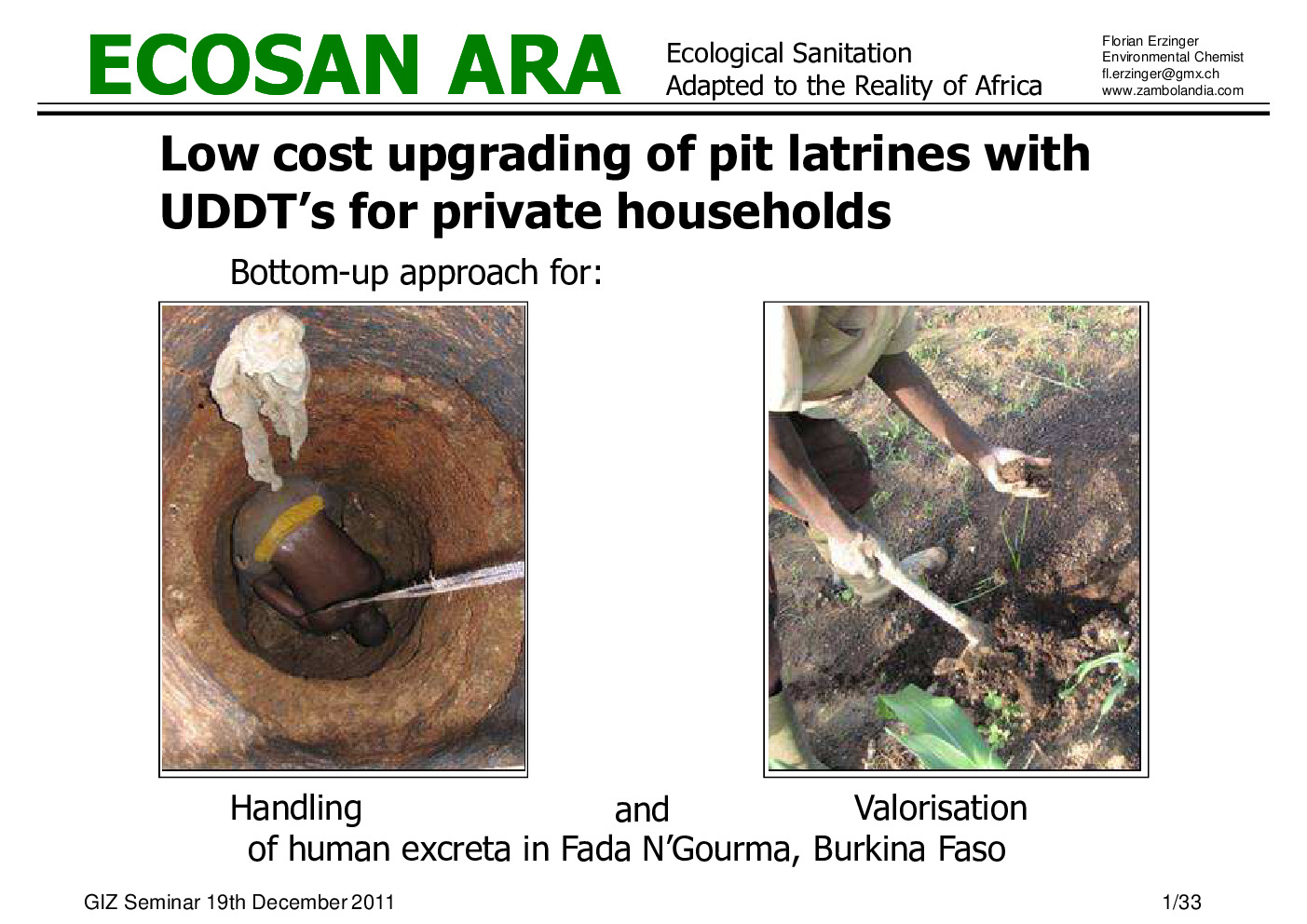-
Containment Collection and transport Treatment Disposal / Reuse
-
Capacity building Finance Information Education and Communication / Behavior Change Communication Infrastructure Policy and processes Technology
-
Access to sanitary toilets Better governance and planning Change in disease burden Collection efficiency of sanitation system Cost recovery Environmental sustainability through reuse, resource recovery, conservation Equity and social inclusion Private sector engagement Quantity of waste safely treated Sanitation practices of the supply side Sanitation practices of the end user
-
Urine Diverting Dry Toilets - Principles, Operation and Construction
All over the world many communities or houses are served by de-centralized water supplies such as standpipes, wells or springs. In many places, even if a centralized water supply system is in place, the system may be regularly interrupted and/or the sewage system may be lacking. These circumstances make the selection of a safe, comfortable and environmentally friendly waterless toilet a nice alternative for many households and communities.Urine diverting dry toilets (UDDT) don’t pollute ground or surface water nor waste drinking water by flushing; by using these specially designed toilets, human feacal matter is diverted from urine and is sanitised and recycled in a safe way. Human fecal matter and urine are considered a valuable resource which can be reused for food production or gardening. No central water supply or sewage system is needed for the proper functioning of these toilets.The design of the toilet makes it easily adaptable to different types of communities, can be constructed with cheap and locally produced materials and can even be constructed inside the house or adjacent to the house. According to the wishes or habits of the users, UDDTs can be designed as a sitting or a squatting toilet. The design can be adapted to the needs of handicapped people as well.
-
Characteristics of Faecal Sludges and their Solids-Liquid Separation
Based on the Field Report Entitled "Sedimentation Tank Sludge Accumulation Study" Prepared by S.A. Larmie WRI (Dec. 1994).
-
Community-led Water and Ecosan Programme Shaanxi Province, China - Case study of sustainable sanitation projects
This case study is about a large-scale community-led water and environmental sanitation project in the rural area of Shaanxi Province, China. Up to June 2007 the project serves approximately 196,000 beneficiaries and has a total investment of € 1.8 million. Objectives of the project are delivery of sustainable health and hygiene benefits to children and their families through improvement in water supply and environmental sanitation as well as the empowerment of the community (decision making power and access to resources). There should be a promotion of eco-sanitation methods to reduce water consumption and recycle nutrients and organics in addition. Another aim is to improve household income through time savings and income earning opportunities particularly for women.In rural China, only 68% of the population has access to safe drinking water and 29% to adequate sanitation. A lot of inhabitants of China’s under-developed regions such as Shaanxi province lack safe drinking water, which forces families to use contaminated water sources that expose them to a range of water borne pathogens. In addition, there is a lack of knowledge about the relationship between hygiene, water quality and good health. The lack of access to basic sanitation increases the contamination of local water sources, degrades the local environment and promotes the spread of disease. It is an old practice in China to use human excreta as fertilizer for crops and vegetables. Therefore, the project area is most suitable for the promotion of ecological sanitation (in the form of urine-diversion dehydration toilets).The first urine diverting toilets of the project were piloted and demonstrated in Sanyong village in Pucheng County during May/June 2005. After the successful pilot of urine diverting toilets in all counties, the construction of these systems grew and the high number in 2066 proved a good acceptance by the people. Three types of latrines have been presented to the community to choose from in the programme area:a) Urine diverting dehydration toilets (65% of the constructed systems)b) Biogas toiletsc) Twin pit series latrines (double urn toilets)By promotion of ecosan systems the hygienic concerns are being addressed, and excreta can be safely utilized for crop fertilization. Mid-term evaluation of the programme was carried out in September 2007. The evaluation showed the improved usage of toilets. Demonstration and cross visits are important tools for community capacity building. Urine diverting toilets proved to be a community-friendly technology in rural China.However, more community mobilization activities should be planned.Community mobilization and gender awareness is a continuous process and cannot be achieved by a single training period.
-
Duckweed Aquaculture - Potentials, Possibilities and Limitations for Combined Wastewater Treatment and Animal Feed Production in Developing Countries
The rapidly growing and small floating aquatic plants of the botanical family of Lemnaceae are capable of accumulating nutrients and minerals from wastewater. The latter are finally removed from the system as the plants are harvested from the pond surface. Because of their comparatively high productivity and nutritional value, particularly their high content of valuable protein, they provide an excellent feed supplement for animals such as fish or poultry. Duckweed holds the potential to create a financial incentive for controlled faeces and wastewater collection in both rural and urban areas and, therefore, improve sanitary conditions. When duckweed biomass is used for animal production, the generation of income and nutritional improvement appear as possible side-benefits from the wastewater treatment process. Thus, the full potential of duckweed aquaculture lies in its combined use in the fields of sanitation, food production and income generation.This literature review provides a first overview of the possibilities, potentials and limits of duckweed aquaculture and its combined use in wastewater treatment and animal feed production in low and middle-income countries. It is somewhat limited as critical literature on duckweed field use is scarce and difficult to obtain (e.g. unpublished internal documents). According to NGOs and commercial suppliers, the duckweed projects seem very positive and promising, and the practical problems encountered with their application rarely mentioned.
-
Solids Separation and Pond Systems for the Treatment of Faecal Sludges in the Tropics - Lessons Learnt and Recommendations for Preliminary Design
The report sets out to provide guidelines for the preliminary design of faecal sludge treatment schemes comprising solids-liquid separation and stabilisation ponds. The document is based on the results of collaborative field research conducted by the Ghana Water Research Institute and SANDEC on full and pilot-scale faecal sludge (FS) treatment plants located in Accra, Ghana. Published and unpublished documents relating to the subject were also reviewed and taken into consideration in the discussion and recommendation of spesific options.
-
Reuse of Human Wastes in Aquaculture - A technical review
New national goals in wastewater treatment in the United States of America place strong emphasis on the use of natural systems and improved biological processes. These goals encourage sewage reuse through agriculture, forestry, and aquaculture (Duffer 1982). However, the cultivation of fish in wastewater has been of interest in the United States for only a short time: from a practical point of view, it remains largely conceptual (Henderson 1982) and experimental (Ryther 1980). A major reason for recent interest in aquaculture in treating wastewater in the United States is its potential to reduce the energy requirements and the operation and maintenance costs of wastewater treatment (Reed et al. 1979). Aquaculture systems -- activated sludge and trickling filters, and tertiary treatment of effluents from secondary treatment systems using stabilization ponds -- might be cheaper, simpler alternativest to conventional secondary treatment( Hendersona nd Wert 1976, Duffer and Moyer 1978, Golueke 1979, Henderson 1982). Waste stabilization pond systems are receiving special attention because, unlike conventional sewage treatment involving activated sludge and trickling filters, they have the potential for nutrient reuse (Mara and Pearson 1986). The utilization of natural waste treatment systems such as aquaculture should reduce energy costs, and the reuse of nutrients in the production of biomass as a feedstuff should produce an economic revenue to offset part of the operating costs.















